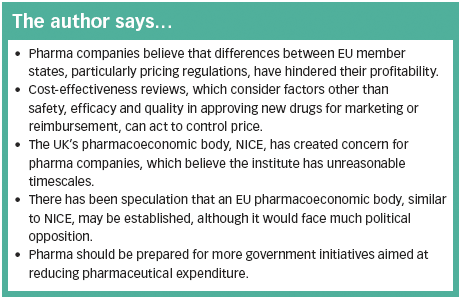Your predictions for 2010
Pharmaceutical Technology Europe
Just before the end of 2009 we gave visitors to our website the opportunity to make some predictions about the 2010 pharma industry… and now it's time for the results.
Sectors experiencing change
Unsurprisingly, when asked which sector of the industry would experience the most change in 2010 (Figure 1), the majority of respondents (25%) voted for regulation policy and enforcement.
Figure 1
Even though 2010 has barely begun, there have already been crucial changes to regulatory procedures in Europe; for example, the eCTD format became compulsory for all electroniconly submissions made via the EMA's Centralised Procedure. 2010 will also mark the final year of the EMA's long-term 'Road Map to 2010' strategy, which was introduced in 2005. In line with the road map, the agency has said its priorities for this year will include strengthening the European medicines network, improving the safety-monitoring of medicines, cooperating with international partners, fostering transparency and provision of information, and stimulating innovation and the improved availability of medicines.
Regulatory challenges may also come about as the EU's 'Pharmaceutical Package', announced in 2008, continues to be discussed by member states. The package contains three legislative proposals concerning access to medicines information, pharmacovigilance and counterfeit medicines.
Outsourcing and contract services, with 20% of votes, was ranked as the second industry sector that will experience the most change this year. Again this result is unsurprising, particularly given the extremely tough year the outsourcing industry was subjected to in 2009 as pharma companies cut back on outsourcing. The consolidation of the industry via M&As, which has increased many companies' manufacturing capacity, has also left the future of CROs and CMOs uncertain. There is some good news for outsourcing service providers in emerging markets, however; the 2010 Trends to Watch: Pharmaceuticals Technology report from Ovum, part of the Datamonitor Group, believes that pharma companies will take advantage of the low costs offered by the abundance of contract service providers in emerging markets.1
Interestingly, the Ovum report explained that information technology, which scored relatively few votes in our survey (8%), would be a trend to watch for 2010, as evolving medicines such as translational medicine and personalised medicine will demand data sharing tools.
The impact of 2009's M&As
More than 50% of respondents to our second survey (Figure 2) believe that the dynamic M&As that took place in 2009 will have a negative impact on this year's pharma industry.
Figure 2
Unfortunately, it looks as if the M&A frenzy is set to continue, with market analysts Datamonitor believing that M&As are a "long-term feature" of the pharma landscape that will contribute almost twothirds of peerset sales growth until 2014.2 A report from KPMG International, Global M&A: Outlook for Pharmaceuticals, adds that the M&A trend is being driven by patent expiries, increased generic competition, stricter regulation and reduced healthcare spending.3
As a whole, businesses involved in M&As benefit by gaining increased manufacturing capacity, new pipeline candidates and increased revenues. For example, according to Datamonitor, Pfizer's acquisition of Wyeth will make it the world's leading prescription pharma company until 2013.4 Before the transaction took place, Roche (inclusive of Genentech), Novartis, SanofiAventis and GlaxoSmithKline were forecast to overtake Pfizer in terms of global prescription pharmaceutical sales by 2013. With regard to the M&A of Merck & Co. and Schering Plough, Datamonitor believes that the transaction will help Merck to return to a positive sales growth outlook.5
KPMG International, on the other hand, warns that "industry's experience shows that megamergers often do not produce the intended synergies, but rather tend to erode shareholder value and create major integration challenges, while not achieving improved new drug pipelines."
In KPMG's report, John Lechleiter, Chairman, President and Chief Executive Officer of Eli Lilly is quoted as saying: "I think we are seeing deals that are really driven more by weakness than what I would describe as strong strategic combinations. They are predicated on synergies and rather massive cost-cutting. That will improve shortterm problems but fail to answer the long-term question of research productivity."
While the effects of megamergers on the companies involved may be ambiguous, there will be negative ripples through the rest of the industry. The outsourcing and contract services industry, for example, has already felt the effects as megamergers lead to increased manufacturing capacity that negates the need for outsourcing.
References
1. 2010 Trends to Watch: Pharmaceuticals Technology (Ovum, November 2009).
2, Datamonitor, "M&A has contributed 63% of Big Pharma sales growth over 1995–2014" (2009). www.datamonitor.com
3. Global M&A: Outlook for Pharmaceuticals (KPMG International, Switzerland August 2009).
4. Datamonitor, "Through acquiring Wyeth, Pfizer will secure place as world's biggest prescription pharma company to 2013" (2009). www.datamonitor.com
5. Datamonitor, "Merck & Schering-Plough: Rare example of mega-merger that is greater than the sum of its parts" (2009). www.datamonitor.com


